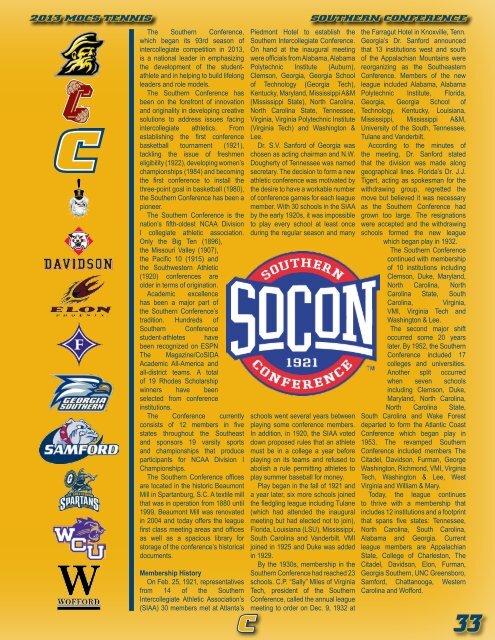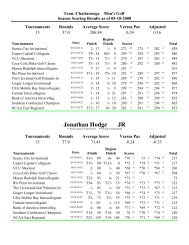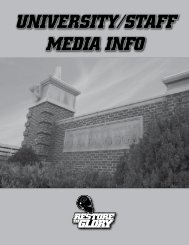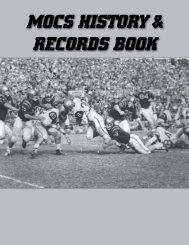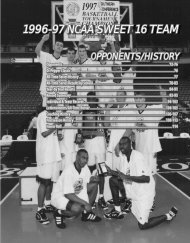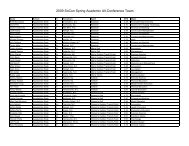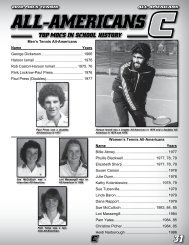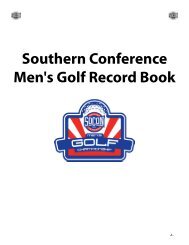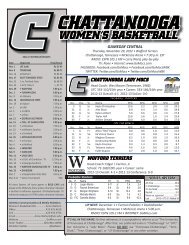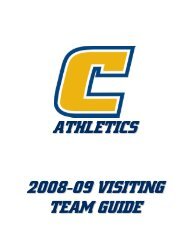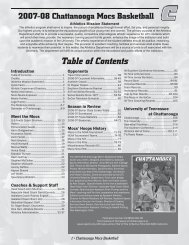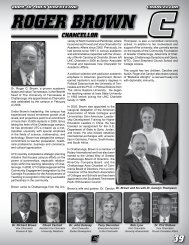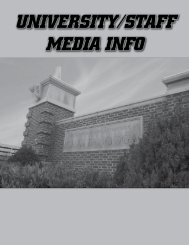2012 TENNIS MEDIA GUIDE - UTC Athletics
2012 TENNIS MEDIA GUIDE - UTC Athletics
2012 TENNIS MEDIA GUIDE - UTC Athletics
You also want an ePaper? Increase the reach of your titles
YUMPU automatically turns print PDFs into web optimized ePapers that Google loves.
2013 Mocs tennis<br />
The Southern Conference,<br />
which began its 93rd season of<br />
intercollegiate competition in 2013,<br />
is a national leader in emphasizing<br />
the development of the studentathlete<br />
and in helping to build lifelong<br />
leaders and role models.<br />
The Southern Conference has<br />
been on the forefront of innovation<br />
and originality in developing creative<br />
solutions to address issues facing<br />
intercollegiate athletics. From<br />
establishing the first conference<br />
basketball tournament (1921),<br />
tackling the issue of freshmen<br />
eligibility (1922), developing women’s<br />
championships (1984) and becoming<br />
the first conference to install the<br />
three-point goal in basketball (1980),<br />
the Southern Conference has been a<br />
pioneer.<br />
The Southern Conference is the<br />
nation’s fifth-oldest NCAA Division<br />
I collegiate athletic association.<br />
Only the Big Ten (1896),<br />
the Missouri Valley (1907),<br />
the Pacific 10 (1915) and<br />
the Southwestern Athletic<br />
(1920) conferences are<br />
older in terms of origination.<br />
Academic excellence<br />
has been a major part of<br />
the Southern Conference’s<br />
tradition. Hundreds of<br />
Southern Conference<br />
student-athletes have<br />
been recognized on ESPN<br />
The Magazine/CoSIDA<br />
Academic All-America and<br />
all-district teams. A total<br />
of 19 Rhodes Scholarship<br />
winners have been<br />
selected from conference<br />
institutions.<br />
The Conference currently<br />
consists of 12 members in five<br />
states throughout the Southeast<br />
and sponsors 19 varsity sports<br />
and championships that produce<br />
participants for NCAA Division I<br />
Championships.<br />
The Southern Conference offices<br />
are located in the historic Beaumont<br />
Mill in Spartanburg, S.C. A textile mill<br />
that was in operation from 1880 until<br />
1999, Beaumont Mill was renovated<br />
in 2004 and today offers the league<br />
first class meeting areas and offices<br />
as well as a spacious library for<br />
storage of the conference’s historical<br />
documents.<br />
Membership History<br />
On Feb. 25, 1921, representatives<br />
from 14 of the Southern<br />
Intercollegiate Athletic Association’s<br />
(SIAA) 30 members met at Atlanta’s<br />
Piedmont Hotel to establish the<br />
Southern Intercollegiate Conference.<br />
On hand at the inaugural meeting<br />
were officials from Alabama, Alabama<br />
Polytechnic Institute (Auburn),<br />
Clemson, Georgia, Georgia School<br />
of Technology (Georgia Tech),<br />
Kentucky, Maryland, Mississippi A&M<br />
(Mississippi State), North Carolina,<br />
North Carolina State, Tennessee,<br />
Virginia, Virginia Polytechnic Institute<br />
(Virginia Tech) and Washington &<br />
Lee.<br />
Dr. S.V. Sanford of Georgia was<br />
chosen as acting chairman and N.W.<br />
Dougherty of Tennessee was named<br />
secretary. The decision to form a new<br />
athletic conference was motivated by<br />
the desire to have a workable number<br />
of conference games for each league<br />
member. With 30 schools in the SIAA<br />
by the early 1920s, it was impossible<br />
to play every school at least once<br />
during the regular season and many<br />
schools went several years between<br />
playing some conference members.<br />
In addition, in 1920, the SIAA voted<br />
down proposed rules that an athlete<br />
must be in a college a year before<br />
playing on its teams and refused to<br />
abolish a rule permitting athletes to<br />
play summer baseball for money.<br />
Play began in the fall of 1921 and<br />
a year later, six more schools joined<br />
the fledgling league including Tulane<br />
(which had attended the inaugural<br />
meeting but had elected not to join),<br />
Florida, Louisiana (LSU), Mississippi,<br />
South Carolina and Vanderbilt. VMI<br />
joined in 1925 and Duke was added<br />
in 1929.<br />
By the 1930s, membership in the<br />
Southern Conference had reached 23<br />
schools. C.P. “Sally” Miles of Virginia<br />
Tech, president of the Southern<br />
Conference, called the annual league<br />
meeting to order on Dec. 9, 1932 at<br />
Southern conference<br />
the Farragut Hotel in Knoxville, Tenn.<br />
Georgia’s Dr. Sanford announced<br />
that 13 institutions west and south<br />
of the Appalachian Mountains were<br />
reorganizing as the Southeastern<br />
Conference. Members of the new<br />
league included Alabama, Alabama<br />
Polytechnic Institute, Florida,<br />
Georgia, Georgia School of<br />
Technology, Kentucky, Louisiana,<br />
Mississippi, Mississippi A&M,<br />
University of the South, Tennessee,<br />
Tulane and Vanderbilt.<br />
According to the minutes of<br />
the meeting, Dr. Sanford stated<br />
that the division was made along<br />
geographical lines. Florida’s Dr. J.J.<br />
Tigert, acting as spokesman for the<br />
withdrawing group, regretted the<br />
move but believed it was necessary<br />
as the Southern Conference had<br />
grown too large. The resignations<br />
were accepted and the withdrawing<br />
schools formed the new league<br />
which began play in 1932.<br />
The Southern Conference<br />
continued with membership<br />
of 10 institutions including<br />
Clemson, Duke, Maryland,<br />
North Carolina, North<br />
Carolina State, South<br />
Carolina, Virginia,<br />
VMI, Virginia Tech and<br />
Washington & Lee.<br />
The second major shift<br />
occurred some 20 years<br />
later. By 1952, the Southern<br />
Conference included 17<br />
colleges and universities.<br />
Another split occurred<br />
when seven schools<br />
including Clemson, Duke,<br />
Maryland, North Carolina,<br />
North Carolina State,<br />
South Carolina and Wake Forest<br />
departed to form the Atlantic Coast<br />
Conference which began play in<br />
1953. The revamped Southern<br />
Conference included members The<br />
Citadel, Davidson, Furman, George<br />
Washington, Richmond, VMI, Virginia<br />
Tech, Washington & Lee, West<br />
Virginia and William & Mary.<br />
Today, the league continues<br />
to thrive with a membership that<br />
includes 12 institutions and a footprint<br />
that spans five states: Tennessee,<br />
North Carolina, South Carolina,<br />
Alabama and Georgia. Current<br />
league members are Appalachian<br />
State, College of Charleston, The<br />
Citadel, Davidson, Elon, Furman,<br />
Georgia Southern, UNC Greensboro,<br />
Samford, Chattanooga, Western<br />
Carolina and Wofford.<br />
33


